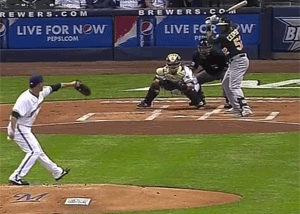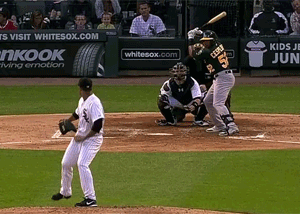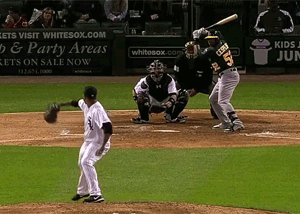Was going to watch Yoenis Cespedes for a week because he was hitting so poorly. Was going to start watching on Tuesday, June 4. He entered the day hitting .229/.302/.447. Yes, you can spot the hole where a better BABIP would provide a convenient fill, but there were plenty of signs that Cespedes was stalled: two steals in seven tries, for instance, after swiping 16 in 20 attempts last year; a .203/.241/.414 line against right-handers, whom he had handled well in 2012.
So that’s where Cespedes was when I sat down to watch a week of him. That was in the past. Now we’re in the future! Isn’t it marvelous? Look at my cellular phone, it has a camera! Also, Yoenis Cespedes is having a good year. Just like that, Cespedes went from having a bad sophomore season for me to write about to having a pretty good season (118 OPS+) for me to write about. What happened in those seven days, you might wonder. Mostly:




It's those four swings I'd like to focus on.
You'll hear a lot about how important it is for pitchers to establish the inside part of the plate. And it is. But it is, if you believe some pitchers, important not for that end unto itself but because owning the inside makes it possible for pitchers to own the outside part of the plate, and that's the part of the plate they really need to own. Here's Bob Gibson, if not the most famous owner of the inside part of the plate then certainly a bona fide tycoon:
Be realistic about it. I hear a lot about pitchers owning the inside corner. No pitcher owns the inside corner. If you're going to own anything on the plate, it's going to be the outside corner. The reason's obvious: Most hitters like the ball from the middle in, so they can turn their hips and yank it into the seats and get on SportsCenter and make a lot of money. So you pitch them away. It's pretty simple stuff, and hard to beat if you back it up with the force of your convictions. If the guy starts looking for the ball away in a manner that's disrespectful of what you're trying to do—if he chooses to venture out there aggressively, without any apparent concern for the consequences—there should be a pretty good chance he'll get it.
You'll also hear, if you ask a manager about the plan of attack against almost any young hitter, that the basic strategy is going to be hard in and soft away: "Pitching 101," one manager told me last summer, talking about that approach to Mike Trout. This is the battle that starts as soon as a hitter reaches the majors: prove you can hit the inside pitch, or it'll be a long and brutal series of one-two punches, inside-outside attacks.
Last year, Yoenis Cespedes was successful, and a big part of that success came from hitting pitches inside. Of his 23 home runs, 15 came on pitches that were at least on the inner half of the plate, and while these sorts of things can be dangerously small samples, this is much of the same data…
…that teams are using to decide how to pitch to Cespedes.
So, the inevitable has happened: the league has adjusted, and that adjustment has gone outside. For every 100 pitches Cespedes sees, about three more are on the outside half of the plate. (This rate stays the same as you go farther out, too; so there are about three more pitches per 100 that are at least four inches from the center of the plate away; three more pitchers per 100 that are at least six inches from the center of the plate outside; etc.)
My week with Cespedes began Tuesday and Wednesday against the Brewers. You can see in his matchups against starters Kyle Lohse and Yovani Gallardo, and relievers Brandon Kintzler and John Axford, the degree to which the Brewers simply conceded the inside part of the plate to Cespedes:
.jpeg)
(1).jpeg)
(1).jpeg)
.jpeg)
Granted, pitch locations aren't always the same as pitch targets, but these pitch locations are (roughly) the same as the Brewers' pitch targets.
So this seems to clearly be an adjustment the league has made, and when the league adjusts to a young hitter we watch closely to see whether we have to adjust our expectations for the hitter. The obligation shifts to the batter to adjust right back. Are there signs that Cespedes is adjusting back? One good indication is this single, against the shift, this week:

Perhaps another good indication is the quartet of home runs up there, three of which were on the outer half, all of which were hit in the center of the field or to right field. The most-pulled homer, of the four, was hit closer to center field than 14 of Cespedes' 23 home runs last year. His scatter plot of home runs this year is a dramatically different picture than the same plot in 2012. We can't conclude that's a good thing, or that it's even proof that Cespedes is adjusting—as opposed to simply being beat—but it's consistent with what you would hope to see if all you knew was that Cespedes was being pitched outside more, away from his strength.
Take a look at the home run he hit against Lohse, the first of the four in the week, as well as his swing against the most similar—by location, velocity, pitcher's throwing hand, and ball/strike count—that he saw in 2012. They're fairly similar swings; you might sense that he's staying back on the pitch a bit more, but you're not really totally sure that you aren't just imagining it—until the final frame, when the difference in approach explodes into view.








The swing really is, in that frame, more contained, more balanced, and more up-the-middle this year that it was last year. These are just two pitches—just two frames!—separated by 10 months, and conclusive of nothing. But it's encouraging to see Cespedes handling that pitch so well this year without having to resort to crowding the plate and diving after it. It's one thing to hit the outside pitch, after all, and quite another to do it in a way that's not disrespectful of Bob Gibson, or likely to give up the inner-half advantage that Cespedes fought so hard to win last season.
Thank you for reading
This is a free article. If you enjoyed it, consider subscribing to Baseball Prospectus. Subscriptions support ongoing public baseball research and analysis in an increasingly proprietary environment.
Subscribe now